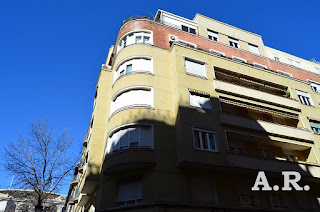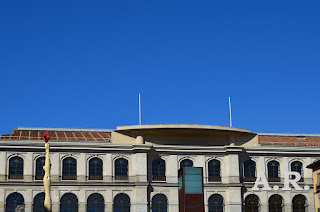Fotografía. Madrid . Ups. Plaza del Museo Reina Sofía. Landscapes of Spain. Reina Sofía Museum square, ups, architecture
Uno de los lugares más fotografiados de Madrid es la plaza del Edificio Sabatini sede del Museo Reina Sofía.
En ella destaca, ademas del propio Museo, el edificio del Real Conservatorio de Música
................El pabellón que alberga el Conservatorio, rehabilitado por los
arquitectos Manuel e Ignacio de las Casas y Jaime Lorenzo, era
anteriormente el Hospital Clínico de San Carlos, anejo a la vieja
Facultad de Medicina y al Hospital General de Atocha, hoy destinado a
Centro de Arte Reina Sofía. A principios del siglo XX, el edificio ya
había sido reformado por el arquitecto D. Cesáreo Iradier para servir de
Clínico, pero en origen se proyectó para formar parte del Gran Hospital
de Atocha (Francisco Sabatini, 1722-1795), edificio complejo e
inacabado en torno a un sistema de patios construido según los cánones
del clasicismo dieciochesco. Sólo se llegó a construir lo que fue
Hospital y hoy es Centro de Arte, y uno de los pabellones, hoy
Conservatorio. ......
y el blanco y geometrico Hotel Mediodia cuya entrada se encuentra en la Glorieta de Atocha.
Está construido sobre el solar del
convento de Santa Catalina. En 1754 se creó la Real Congregación de Hospitales
a la que se le encargó la construcción del Hospital de Madrid. La congregación
pidió unas trazas a Ventura Rodríguez, que presentó dos años después y que no
fueron aceptadas. Posteriormente, José de Hermosilla, capitán de ingenieros,
fue el encargado del proyecto "cuyas obras empezó y dirigió hasta sacarlas
fuera de cimientos y elevarla en algunas partes hasta el piso principal" escribió
Antonio Ponz. Pero al subir Carlos III al poder, pidió a Francisco Sabatini que
se hiciera cargo de las obras y les diera una mayor envergadura. El proyecto de
Sabatini superaba en dimensiones al Palacio Real y sirvió de modelo al Gran
Hospital de París. Constaba de cinco patios, más otros dos encuadrando la
iglesia, y la fachada principal estaba en la calle Atocha
Destaca también la escultura de Alberto Sánchez
El pueblo español tiene un camino que conduce a una estrella (maqueta)
..........Esta obra es la maqueta realizada por Alberto para la obra homónima, cuya versión definitiva, de 12,5 metros de altura, se situó en el exterior del Pabellón Español de la Exposición Internacional de París de 1937. La maqueta ingresó en la colección del Museo Reina Sofía tras su localización en los sótanos del Palacio de Montjuic de Barcelona en 1986, junto con otras obras procedentes del Servicio de Protección del Patrimonio Artístico. En esta escultura, Alberto aplicó un «título-proclama» político que ponía de relieve, desde un punto de vista socialista, el drama y el dolor de un pueblo inmerso en una Guerra Civil. Asimismo, la obra fue concebida como una reafirmación de la vanguardia frente a los que defendían un arte de compromiso político ligado al realismo ....
En (google translate)
One of the most photographed places in Madrid is the Plaza Building Sabatini headquarters Reina Sofia Museum.It highlights, besides the Museum itself, the building of the Royal Conservatory of Music
................ The pavilion that houses the Conservatory, renovated by architects Manuel and Ignacio de las Casas and Jaime Lorenzo, was formerly the Clinical Hospital of San Carlos, I attached the old Faculty of Medicine and the General Hospital of Atocha, today aimed at Centro de Arte Reina Sofía. In the early twentieth century, the building had been renovated by architect D. Cesáreo Iradier to serve as Clinical, but originally was planned to be part of the Great Hospital of Atocha (Francisco Sabatini, 1722-1795) complex and unfinished building around a system of courtyards built on the lines of the eighteenth classicism. He just came to construct what was Hospital and today is Art Center, and one of the pavilions, today Conservatory. .....
and white geometric Hotel Mediodia whose entrance is in the Glorieta de Atocha.Monumenta Madrid. Sabatini buildingIt is built on the site of the convent of Santa Catalina. In 1754 the Royal Hospital Congregation which was entrusted with the construction of the Hospital of Madrid was created. The congregation asked a trace to Ventura Rodriguez, who introduced two years later and were not accepted. Later, José de Hermosilla, captain of engineers, was the project manager "whose works started and directed to take them out and raise foundation in parts to the main floor" wrote Antonio Ponz. But climbing Carlos III to power, he asked Francisco Sabatini to take charge of the work and give them a greater scope. The draft Sabatini size exceeded the Royal Palace and served as a model to the Great Hospital in Paris. He had five patios, plus two framing the church, and the main facade was in Atochaalso it highlights the sculpture by Alberto SanchezThe Spanish People have a Path that Leads to a Star (demo).......... This work is the model made by Alberto for the homonymous work, the final version, 12.5 meters high, stood outside the Spanish Pavilion at the Paris International Exhibition 1937. the model entered the collection of the Reina Sofia Museum after its location in the basement of the Palace of Montjuic in Barcelona in 1986, along with other works from the Service for the Protection of Artistic Heritage. In this sculpture, Alberto applied political "title-proclaimed" which highlighted, from a socialist point of view, the drama and the pain of undergoing a Civil War people. In addition, the work was conceived as a reaffirmation of the vanguard against the defending an art of political commitment linked to realism ....
................ The pavilion that houses the Conservatory, renovated by architects Manuel and Ignacio de las Casas and Jaime Lorenzo, was formerly the Clinical Hospital of San Carlos, I attached the old Faculty of Medicine and the General Hospital of Atocha, today aimed at Centro de Arte Reina Sofía. In the early twentieth century, the building had been renovated by architect D. Cesáreo Iradier to serve as Clinical, but originally was planned to be part of the Great Hospital of Atocha (Francisco Sabatini, 1722-1795) complex and unfinished building around a system of courtyards built on the lines of the eighteenth classicism. He just came to construct what was Hospital and today is Art Center, and one of the pavilions, today Conservatory. .....
and white geometric Hotel Mediodia whose entrance is in the Glorieta de Atocha.Monumenta Madrid. Sabatini buildingIt is built on the site of the convent of Santa Catalina. In 1754 the Royal Hospital Congregation which was entrusted with the construction of the Hospital of Madrid was created. The congregation asked a trace to Ventura Rodriguez, who introduced two years later and were not accepted. Later, José de Hermosilla, captain of engineers, was the project manager "whose works started and directed to take them out and raise foundation in parts to the main floor" wrote Antonio Ponz. But climbing Carlos III to power, he asked Francisco Sabatini to take charge of the work and give them a greater scope. The draft Sabatini size exceeded the Royal Palace and served as a model to the Great Hospital in Paris. He had five patios, plus two framing the church, and the main facade was in Atochaalso it highlights the sculpture by Alberto SanchezThe Spanish People have a Path that Leads to a Star (demo).......... This work is the model made by Alberto for the homonymous work, the final version, 12.5 meters high, stood outside the Spanish Pavilion at the Paris International Exhibition 1937. the model entered the collection of the Reina Sofia Museum after its location in the basement of the Palace of Montjuic in Barcelona in 1986, along with other works from the Service for the Protection of Artistic Heritage. In this sculpture, Alberto applied political "title-proclaimed" which highlighted, from a socialist point of view, the drama and the pain of undergoing a Civil War people. In addition, the work was conceived as a reaffirmation of the vanguard against the defending an art of political commitment linked to realism ....
R201602
Recuerde que haciendo click en la foto se ve a mayor tamaño





